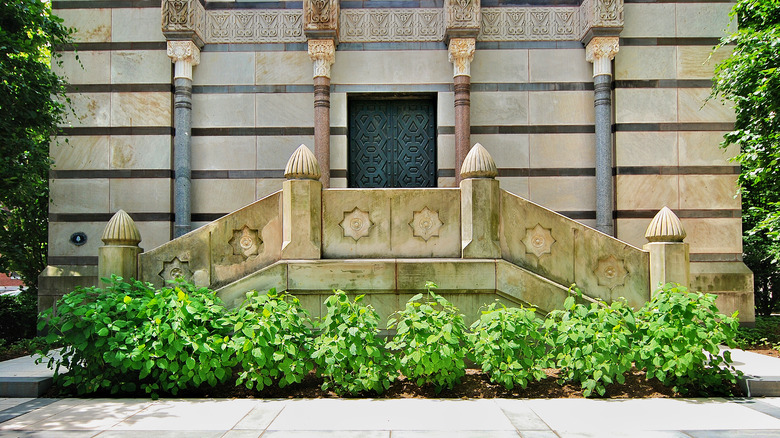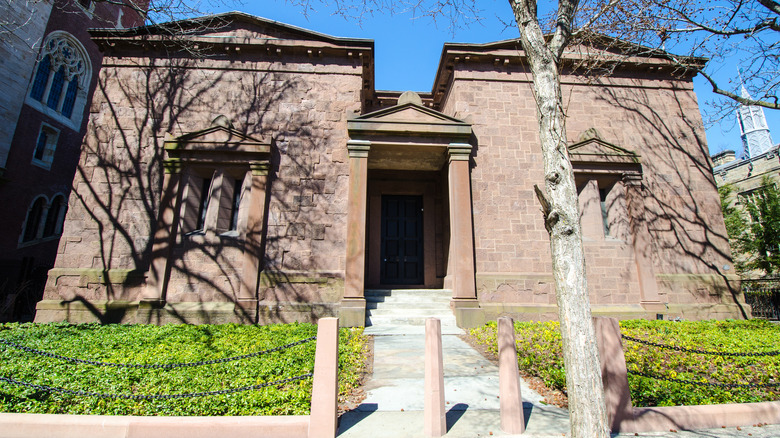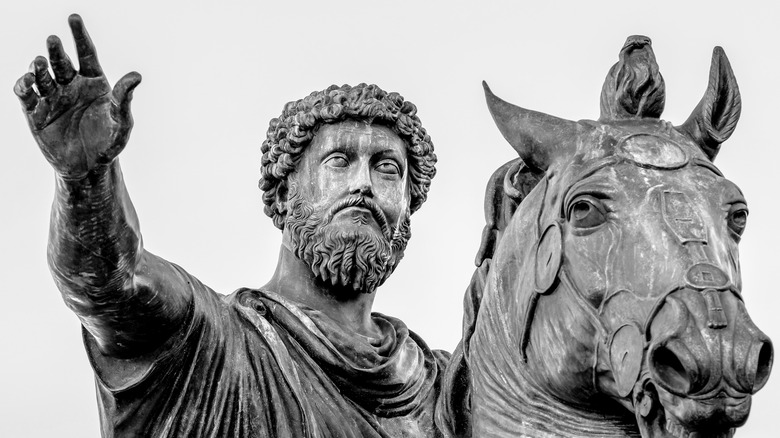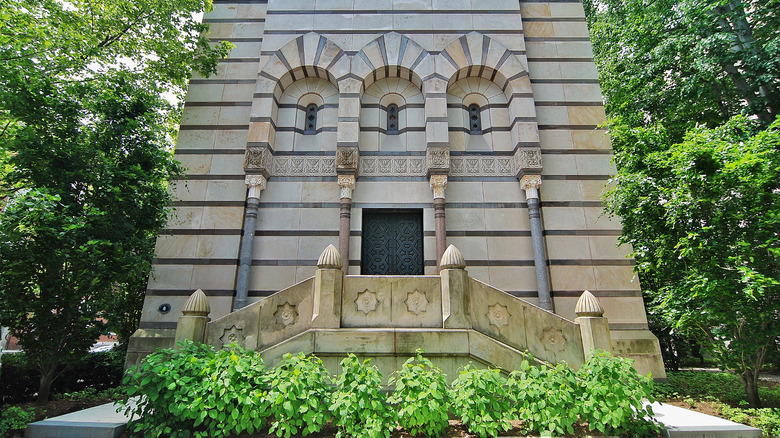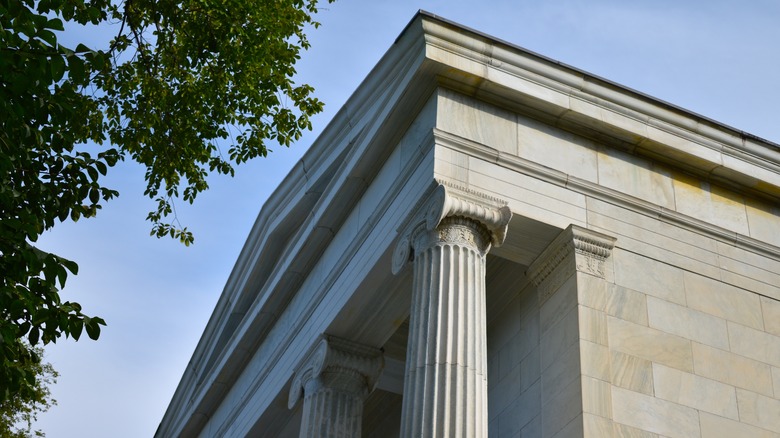Yale Has More Secret Societies Than You Realize. Here's The History
Yale University is one of the oldest, most exclusive, and most prominent colleges in the United States. The list of important figures — like politicians, scientists, entertainers, entrepreneurs, billionaires, and more — who've graduated from Yale is too long to include here, but trust us when we say, it's long. With such a commitment to excellence, it goes without saying that it's incredibly difficult to get into this university.
But even if you've been accepted into Yale, it doesn't mean you're automatically granted access to all of its resources and perks. The university is home to numerous secret societies, some of which go back to the 1800s. Because of the clandestine activities that take place within these societies and the incredibly small number of members they allow (most secret societies don't admit more than 15 people), they're even more choosy than Yale about who they accept.
While most people are familiar with Skull and Bones, Yale has several more secret societies — that we know about, that is. True to their description, there's not much consensus on how many secret societies there actually are at Yale. A 2014 Yale Alumni Magazine article says there are 41, while a 2018 event listing says there are 47. We won't go through all of them, but let's take a look at some of the most storied and notorious of Yale's secret societies.
Skull and Bones Society
As Yale's oldest secret society, the origins of the Skull and Bones Society are a bit of a mystery to this day. William Huntington Russell and Alphonso Taft founded it in 1832, with some reports claiming its inception was the result of a squabble with Phi Beta Kappa. Other reports claim its birth was inspired by other similarly styled organizations Russell came across during his time studying abroad in Europe.
Regardless of how Skull and Bones came to be, the society is steeped in old traditions. The number "322" is of great importance to them, although its significance, like the group's origins, is still up for debate. It's generally believed that the number was chosen in honor of the year (322 BCE) when Greek orator Demosthenes died, leading to a drastic change in Athens' government. Those who are admitted into the ranks of Skull and Bones are notified not by an official acceptance letter, but by a secret clap on the shoulder from an existing member.
When a club has a name like Skull and Bones, it makes sense that many of its goings-on would be kept under wraps. However, one thing that the secret society has never been mum about is its roster, which includes no less than three U.S. presidents: William Howard Taft, George H.W. Bush, and George W. Bush. Many other prominent public figures were members of Skull and Bones, including John F. Kerry, William F. Buckley, Henry Luce, and others.
Aurelian Honor Society
The Aurelian Honor Society was born in 1910 as an attempt by members of the Sheffield Scientific School to unify a student body frayed by various fraternities. At the time, membership was only granted to Sheffield students who demonstrated exceptional ability both in their studies and extracurricular activities, but the society has since diversified its recruitment.
The philosophies of the Roman Emperor and stoic thinker Marcus Aurelius serve as the basis of the Aurelian Honor Society, which is named after Aurelius. His ideals are illustrated in their emblem, which consists of a wreath encircling a seven-pointed star, with each point representing a different collegiate virtue: Executive, Scholarship, Religious, Scientific, Athletic, Literary, and Oratorical.
All of this may make the Aurelian Honor Society seem like one of Yale's more morally upstanding secret societies, but they've gotten into their fair share of trouble. In 2017, the club was banned from using the fourth floor of Sheffield-Sterling-Strathcona Hall as a gathering place due to a string of concerning events, stemming from a case of underage drinking that took place in 2012.
According to Yale Daily News, Dean of Student Affairs Camille Lizarríbar wrote in an email to the society's leaders that, "while these incidents are recent ones, in fact there are numerous previous incidents establishing a pattern of cyclical problematic conduct not only towards the room itself, but more significantly towards the safety of students and the integrity of Yale College property."
The Pundits
While the Pundits' years of history (it was founded in 1884) may initially put it in the same illustrious league as some of the other 19th-century secret societies, its penchant for troublemaking makes it an oddity among its more decorous contemporaries. For more than a century, the society has had a reputation for playing pranks on students and professors alike, and has become notorious for their naked parties. That's right — parties wherein everyone is required to take off all their clothes. Of course, the Pundits will often spice things up a bit (as if nude shindigs needed more spicing up) with different themes, like naked cocktail parties and naked sushi bashes.
As raucous as the Pundits are, however, they're not completely without old-school prestige. Barbara Bush, daughter of former U.S. President George W. Bush, supposedly wanted to join the Pundits despite being tapped for Skull and Bones, which her father was a member of. (It's said by the Pundits that she did attend one of their naked parties, though this may be yet another one of their attempts to thumb their noses at the establishment.) One of the society's more surprising alumni is McGeorge Bundy, an intelligence officer during WWII and U.S. National Security Advisor who championed the country's involvement in the Vietnam War. Maybe it was his previous experience partying in the buff that led to his playing such major roles in America's wars?
Scroll and Key
Scroll and Key is another one of Yale's oldest and most storied secret societies. Established in 1842, the story is that Yale students William Kingsley, John Porter, and William Huntington were perturbed about getting passed over by Skull and Bones, so to retaliate, they set up their own secret society.
Possibly to compete with its slightly more famous rival, Scroll and Key also recruits members who excel not just in their studies, but in activities outside of academic work. Like the other members of Yale's first generation of secret societies, Scroll and Key commissioned a dignified tomb for its gatherings, this one designed by acclaimed architect Richard Morris Hunt. David Alan Richards, author of "Skull and Keys: The Hidden History of Yale's Secret Societies," told Curbed that, "Hunt built in a Moorish revival, almost mosque-like style. The façade highly decorative and colorful stonework in yellow and purple."
The society also boasts a list of notable alumni, including composer and songwriter Cole Porter, pediatrician Dr. Benjamin Spock, and cartoonist Garry Trudeau. However, the Scroll and Key's stellar alumni list goes back even further — members of the Rockefeller and Vanderbilt families were members of the society, as well as descendants of families who arrived in America on the Mayflower. With this kind of pedigree, is it any wonder why Scroll and Key has one of the more serious and illustrious reputations at Yale?
Berzelius
Berzelius, established in 1848, was once one of Yale's most prestigious and mysterious secret societies. In addition to being one of the university's oldest secret societies, it was named after Jöns Jakob Berzelius, a 19th-century scientist who was massively influential in the development of chemistry. Its clubhouse was built in a classic Greek style and its mission is to "promote an open, honest exchange of experiences, passions, and opinions, and in the process of getting to know other people, to find insights into ourselves."
However, the society has lost acclaim in recent years. According to Yale Daily News, despite its long history, Berzelius lacks the generous funds of other, similarly old secret societies. In fact, it's even known to most students as a "party society." The society's members have even been accused of vandalism in a nearby neighborhood. In 2018, Yale Daily News reported an incident in which some Berzelius members were accused of throwing a rock through a shop window after they were seen leaving their clubhouse late one night, wearing cloaks and causing a ruckus. The store's owners attached a sign on the broken window that attributed the damage to the members of Berzelius, "a Yale secret society whose goals include 'a moral life ... devoted to good character ... (and service) to their communities.'"
Book and Snake
Book and Snake is another one of Yale's oldest secret societies. It was established in 1863 and was first called Sigma Delta Chi, adopting its current name sometime later to differentiate itself from the typical fraternity system at the university. While the name was changed, Book and Snake retained some of its Greek heritage. David Alan Richards, author of "Skull and Keys: The Hidden History of Yale's Secret Societies," told Curbed that "the Book and Snake tomb, built in 1901, is supposed to be the most perfect reproduction of a Greek temple in the United States. It even has a roof made of marble plates."
The club's membership has changed quite a bit since its inception. The society initially grew out of the Yale Sheffield Scientific School, but largely focused its attention on finding members who excelled in athletic activities and school journalism. Some of its most famous alumni further demonstrate how varied its membership has been, with many of them forging careers in or adjacent to politics. According to "Decoding The Lost Symbol: The Unauthorized Expert Guide to the Facts Behind the Fiction," alumni include Porter Johnston Goss, a congressman and former director of the CIA; Nicholas F. Brady, Secretary of the Treasury under presidents Reagan and Bush Sr.; Les Aspin, former Secretary of Defense; and others.
Elihu Club
The Elihu Club (named after the primary benefactor of the university, Elihu Yale) was founded in 1903, and is Yale's fourth oldest secret society after Skull and Bones, Scroll and Key, and Wolf's Head. Its official website states that the society's purpose is to cultivate "a stronger affection for Yale; a broader view of undergraduate life and its aims; a deeper and more helpful friendship for one another; and to give its members, after graduation, an additional tie to bind them to Yale and to each other."
Despite its elder status, the Elihu Club differs quite a bit from its 19th-century colleagues. For one, it was established to accept men who'd been rejected by other societies. But its male-only membership wouldn't last forever, as it would eventually accept women into its ranks. As one of the more modern and progressive societies on campus, Elihu gives all juniors an opportunity to apply for membership. Of course, because of its more inclusive policy, the club isn't considered as elite as some of the other clubs on campus.
Still, Elihu does have a few distinguishing traits. Since 2002, the society has hosted the Elihu Yale Lecture series, which has featured appearances from a wide range of notable figures. One of its standout speakers was Yale alumni and Oscar-nominated actor Sam Waterston, most famous for his role on the TV show "Law & Order."
Mace and Chain
If you're not good enough to attract the attention of a secret society, might as well start your own. That's how Mace and Chain came to be. Thornton Marshall, who graduated from Yale in 1957, founded the society when his roommate got invited to join not one, but two societies — while being completely passed over himself. "I was annoyed, angered, and insulted — twice. I wanted to have my day in the sun," Marshall told Yale Alumni Magazine. And so he got a group of buddies together and started Mace and Chain. It's existence was solidified when two-time Pulitzer Prize-winning poet, novelist, and literary critic Robert Penn Warren (who was an English professor at Yale at the time) gave Marshall some advice on the direction of the club, prompting them to allow input from professors and give every member a chance to serve as president.
The involvement of alumni makes Mace and Chain one of the more versatile secret societies, as the outside influence allows it to grow and change on a frequent basis. It also means no shortage of perks for members, who get treated to such fringe benefits as extravagant meals, theater tickets, and more. When the society had remained largely dormant for decades, Mace and Chain alumni Tom Haines and William "Biff" Folberth teamed up to revive their old club, helping them secure a 180-year-old house near campus to serve as its permanent hangout.
Manuscript Society
The concept of building a structure specifically for a secret society may be a quaint relic from the 1800s, but the tradition lasted well into the 20th century. For example, the Manuscript society, which was established in 1951, got its own building the very next year. Yale architecture professor King-lui Wu designed it in a more contemporary style to set it apart from the antiquated aesthetics that typified other secret societies' tombs.
This was undoubtedly due to the fact that the Manuscript Society's membership consisted primarily of artists and creative types. Since its founding, the club has counted such prominent cultural figures as Jodie Foster and Anderson Cooper among its members. The society's building's bohemian theme is bolstered by artsy décor that includes fine art adorning the walls and a Japanese water garden.
The Manuscript Society has broken from some traditions that most of the original secret societies adhered to over the years. For example, they're not quite as secretive as their contemporaries, as they allow guests of members to attend events they host throughout the school year. The club is also far more lenient about accepting members of different specialties. Clay Dean, a former Manuscript president, told Yale Daily News that the group is "a kind of utopia because it's the best combination of informed conversations in an ideal setting — which is to say, around a dinner table."
Wolf's Head
Wolf's Head was established by William Lyon Phelps in 1883. Instead of going down the same path of secrecy as the other societies on campus, Wolf's Head members prioritized exclusivity, choosing to talk openly about the club while being extra selective about who to let in. However, this didn't last long, and the society later opted to keep itself as unknown as possible.
Wolf's Head was initially based out of a structure designed by the prestigious architectural firm McKim, Mead, & White, showcasing a stunning Dutch Ratskeller style. The society's earliest members raised funds for their elegant hangout in a clever way, according to David Alan Richards, author of "Skull and Keys: The Hidden History of Yale's Secret Societies." Richards told Curbed that members "
"went to Yale alumni from classes before 1883 that hadn't been in either (Skull and) Bones or in (Scroll and) Key and offered honorary membership in exchange for a contribution. They were able to raise money for their clubhouse that way." Unfortunately, today's members can no longer gather in the space — it's currently used as office space and is the property of Yale.
Wolf's Head was been male-only for more than a century, but after a controversy erupted around attempts to make Skull and Bones co-educational in 1991, Wolf's Head did away with its outdated policy and began letting in female students. The society has a roster of reputable alumni, ranging from hedge fund manager Tom Steyer to composer Charles Ives.
